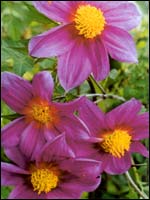Plant Profile: Tree dahlia
Family: Asteraceae Type: Herbaceous perennial Size: 3-5m tall Commonly known as the tree dahlia, this plant has similar habits to the regular garden dahlia, but with one big difference — it can shoot up to towering heights in short time spans. The delicate tree dahlia bears huge leaves and shaggy lavender flowers with yellow centres. Its stems are tall, straight and thin, much like bamboo stems. The dramatic, pendulous flowers bloom from late autumn — generally in May and June. There are a number of species close to the D. imperialis, including D. tenuicaulis , D. rudis and D. scapigeroides , none of which are as large imperialis. Parva Plants (info@parva.co.nz) have a small range of tree dahlias for sale including the fairly new cultivar, D. 'Timothy Hammett' (photo above). Unlike other imperialis, this variety doesn't flower just in late autumn but throughout summer and autumn. The plant is slightly smaller in size and less pendulous, but the indiviudal blooms are, nevertheless, hugely attractive. Ideal conditions Generally the tree dahlia is a fairly easy plant to grow. Plant in a sunny spot with shelter from wind and frost — they can, however, withstand light frosts. Their brittle stems can quite easily be broken by gusts of winds, so it may pay to stake them. They do best in moist soils that are well drained. Never plant in an area that is prone to waterlogging. Although they die away annually, they will need a bit of pruning throughout the year. The best time to give them a prune is just after flowering (in winter). They are fairly pest resistant, although powdery mildew can attack some plants, and moth caterpillars may take a liking to them. To propagate, take stem cuttings. Place 30cm long cuttings, each with at least two nodes, in soil either horizontally or vertically.
|
Home | Journal
| Newsletter | Conferences
Awards | Join
RNZIH | RNZIH Directory | Links
© 2000–2025 Royal New Zealand Institute of Horticulture
Last updated: June 2, 2004


 Botanical name: Dahlia imperialis
Botanical name: Dahlia imperialis